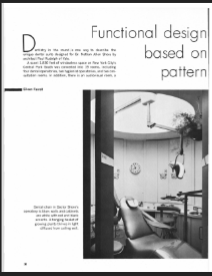On August 24, 2022, the Commonwealth of Massachusetts issued an announcement designating Leggat McCall Properties as the redevelopment partner for the Charles F. Hurley Building also known as the Boston Government Services Center. You can read a copy of the announcement here.
After reviewing the announcement and the renderings attached to it, DocomomoUS and The Paul Rudolph Institute for Modern Architecture issued the following joint press release:
FOR IMMEDIATE RELEASE
Contact: Kelvin Dickinson
E: office@paulrudolph.institute
P: 917-242-0652
Docomomo US and The Paul Rudolph Institute for Modern Architecture (PRIMA) are jointly responding to the August 24, 2022, announcement by the Commonwealth of Massachusetts on the designation of Leggat McCall Properties as the redevelopment partner for the Charles F. Hurley Building also known as the Boston Government Services Center originally designed by the world-renown architect Paul Rudolph and opened in 1971.
We see the announcement and the attached renderings as just one step in the process of determining the best outcome for the Hurley building and the overall site. We are frustrated that the proposal does not fully preserve and restore the site that the Massachusetts Historical Commission describes as a “significant cultural resource.” The proposal lacks many details in terms of just how much of the original building and its significant features will be removed. While the proposal does not call for total demolition of the building, we will continue to ask the state to maintain as much of the original fabric as possible.
From the current renderings, the two new towers do not seem compatible with one another or the historic building (different materials, colors, and massing) and appear to be separate blocks that have “landed” on the Hurley rather than integrate with the original structure or each other. Our suggestion would be that the team consider reviewing Paul Rudolph’s original design guidelines for the site and work to better integrate any new construction with that methodology.
We are pleased to see the street wall that faces Staniford Street maintains the look and feel of the original design and retains the site's character defining features including the massive colonnade of concrete piers.
We anticipate seeing improved and expanded details that will show how the proposal respects the cultural heritage of the site. From the minimal details provided: the landscaping does not go far enough to be respectful; the announcement included no mention of the conservation of the Costantino Nivola murals; the proposal lacks to a description of how the parking garage will be integrated; nor does the announcement detail the Lindemann stairs that were said to be restored with this proposal.
Speaking on behalf of Docomomo US, Liz Waytkus stated that, “The interventions at the Government Center need to harmonize with the historic site. The announcement yesterday lacked a lot of information as to how that is going to happen. Docomomo US will continue to follow along and engage in this process."
"Rudolph's building is a monument to the government's service to its people and their confidence in the future of Boston," said Kelvin Dickinson, President of The Paul Rudolph Institute for Modern Architecture. "Using spatial motifs that reference Boston's historic connection to the sea, the Government Center is a unique symbol of its time and place. The revisions proposed in yesterday's announcement need to better show how they are consistent with the design guidelines Rudolph established for the site. The Paul Rudolph Institute will follow and encourage this throughout the design process."
###
You can download a copy of this press release here.




![Philp Johnson’s 1997 design: a “dog house” on the Glass House estate. According to the National Trust for Historic Preservation’s website: “This small structure was created by Johnson as a conceptual project for a classically-inspired tomb. However, when completed the small wooden object turned out to be just the right size for his and [David] Whitney’s new puppies to inhabit. . . .”](https://images.squarespace-cdn.com/content/v1/5a75ee0949fc2bc37b3ffb97/1631026468289-HZPCE6M866A7YQ4ZBZP2/Urban+dog+johnson+doghouse.jpg)































